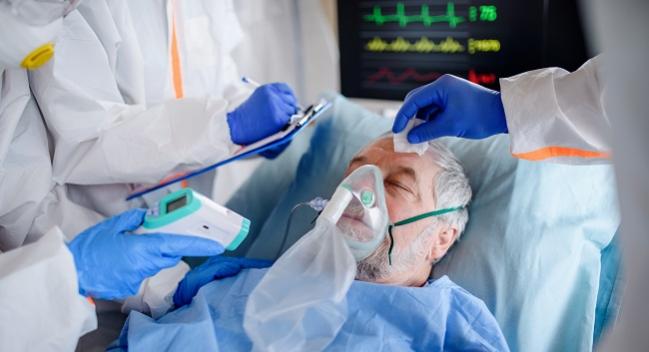COVID-19 Clots Spur Both Arterial, Venous Events in Hospitalized Patients
It’s not just the sickest people requiring ICU care who are at risk, according to NYC data.

COVID-19’s hallmark thrombotic risk exists across all hospitalized patients, not just the sickest who require ICU-level care, data on more than 3,000 people suggest. Moreover, researchers say, these venous and arterial events are accompanied by heightened mortality.
The results, from a four-hospital system in New York City, were published online earlier this week in JAMA.
“To me, the most compelling aspect is the incidence. People have been talking about clotting a lot in COVID-19, but I think most of the studies have been very small and most of the studies have only looked at patients in the intensive care unit,” senior author Jeffrey S. Berger, MD (NYU Langone Health, New York, NY), told TCTMD.
Here, taking a broader perspective, nearly one in six hospitalized COVID-19 patients at their center developed thrombosis. “Basically, both arterial clots like heart attacks and strokes as well as venous clots like DVTs [deep vein thromboses] or pulmonary emboli, they’re all present,” he said. “Without understanding the magnitude and how serious it is, it’s really hard to think about what to do next.”
Unfortunately many patients don’t come in—they just die of a blood clot at home. Jeffrey S. Berger
Then there’s the question of why these clots are happening, Berger continued. The events in the current report are clinically apparent “macroclots,” different but perhaps on the same trajectory of the microthrombi that have been documented both by their group and others, he pointed out.
Together, these events cast a wide net and contribute to mortality, said Berger. “We think clotting is forming very early in the disease state, and clotting can obviously lead to these giant clots, these clinical thrombotic events. I personally believe that they can also lead to a lot of other events that people do not normally attribute to clotting, like acute kidney injury. I think people are requiring much more mechanical ventilation because of all the microclots in their lungs.”
Hospitalized patients represent just the “tip of the iceberg,” he observed. Beyond the people who develop COVID-19 but don’t seek care, there are those who have been discharged. “Patients, once they leave the hospital, are coming back in with blood clots. Unfortunately many patients don’t come in—they just die of a blood clot at home.”
An ‘Immense Problem’
In their research letter, Berger, along with lead author Seda Bilaloglu, MS (NYU Langone Health), and colleagues, describe 3,334 consecutive patients (median age 64 years; 39.6% women) hospitalized with COVID-19. Thrombotic events occurred in 16% of these patients. Most common were arterial events, seen in 11.1%, while 6.2% of patients had venous events. Broken down by type, 8.9% had MI, 3.9% deep vein thrombosis, 3.2% pulmonary embolism, 1.6% ischemic stroke, and 1.0% systemic thromboembolism.
Thrombosis was more common among the 829 ICU patients, of whom 13.6% and 18.6% had venous and arterial events, respectively. For the 2,505 non-ICU patients, rates of venous and arterial events were 3.6% and 8.4%.
Patients who experienced these events were more likely to die than those who did not (43.2% vs 21.0%; P < 0.001). Adjusted for baseline differences, this mortality risk was seen after both venous (HR 1.37; 95% CI 1.02-1.86) and arterial thromboses (HR 1.99; 95% CI 1.65-2.40).
Independent predictors of thrombotic events included age 55 to 64 and ≥ 75 years (versus younger than 45), male sex, Hispanic ethnicity, coronary artery disease, and prior MI. Higher D-dimer levels at hospital presentation also were strongly linked to thrombosis, especially in the veins. Compared to those with a D-dimer value below 230 ng/mL, risk was doubled for the 26% of patients with values of 500 to 1,999 ng/mL and increased sevenfold for the 3% of patients whose D-dimer reached 10,000 ng/mL or higher.
These data confirm that “D-dimer is a good marker of risk,” said Berger. “There’s some suggestion it may be involved in the pathogenesis, but I think that’s purely speculative. I would not state that equivocally without a doubt at this point.”
As noted in the paper, this study doesn’t pinpoint why COVID-19 has prothrombotic effects, and the causes are likely manifold, the investigators write. “Thrombosis in patients with COVID-19 may be due to a cytokine storm, hypoxic injury, endothelial dysfunction, hypercoagulability, and/or increased platelet activity.” For Berger, the most likely culprit is platelet activity, though he said this needs to be borne out by research.
Also unknown, he stressed, is how best to prevent these events. NYU Langone Health is leading a large randomized trial of anticoagulation strategies and is working with the National Institutes of Health’s ACTIV initiative to “target this immense problem,” he said.
In terms of immediate advice for clinicians and hospitals facing a surge in infections, Berger urged “a bit of caution that potent blood thinners have a significant side effect profile.” With the best therapy still elusive, “I really think we should be working together in the medical community to answer these questions. . . . The sooner we get an answer, the sooner we’ll be able to appropriately instruct patients and healthcare professionals how best to treat patients,” he said.
Caitlin E. Cox is News Editor of TCTMD and Associate Director, Editorial Content at the Cardiovascular Research Foundation. She produces the…
Read Full BioSources
Bilaloglu S, Aphinyanaphongs Y, Jones S, et al. Thrombosis in hospitalized patients with COVID-19 in a New York City health system. JAMA. 2020;Epub ahead of print.
Disclosures
- Berger reports receiving grants from AstraZeneca and personal fees from Janssen and Amgen outside the submitted work.
- Bilaloglu reports no relevant conflicts of interest.


Comments